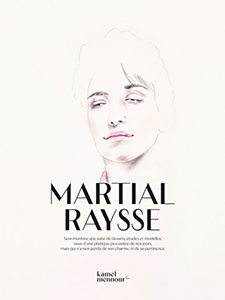The hundred or so
drawings gathered in this monograph provide an intimate glance into the work of Martial Raysse, making available for the general public a body of work that has been little known until now. With an introduction by
Anaël Pigeat.
To begin with, with Martial Raysse there are always women, doubtless the first of his subjects. Rebecca (1996) brings to mind the Mona Lisa, but we could have also passed her yesterday in the metro. Her portrait is surrounded by long brush strokes of brown and purple gouache. This is the artist's palette and the most elegant dress she wears. You have the impression of catching him at work, as you do with the succession of certain variations, like the charcoal drawing of La Charmante Nad who reappears in Nad (2000) dressed in red and surrounded by field flowers. Are these two images a few minutes or a few days apart? Raysse's drawings say much about his practice. Everything is permitted, all the pencils, all papers and collages, including photocopies, all the pirouettes and acrobatic turns imaginable.
At first, the most arresting thing about the large compositions he made in the 1960s is their high level of relief: the plastic deer antlers, the fake plants, the plywood fragments of beach and landscape. His drawings are also often in three dimensions, like in the studies for La Source (1990) for instance, in the small collages where girls' heads have been cut out and attached to busts that are slightly too small. There are also swimming costumes glued onto models' bodies, like the cut-out dress-ups young girls play with. These collages, no less vehicles of fantasy, indicate stages in a scrupulous working process, with all its adjustments. They can also be a bit of a joke—or are they not really?—like the child from the Bronzino painting whom a crown of lily flowers added to his head in Place d'Assas à Tolède (1993) has transformed into a prince.
Published on the occasion of the eponymous exhibition at galerie Kamel Mennour, Paris, from March 16 to April 22, 2017.














